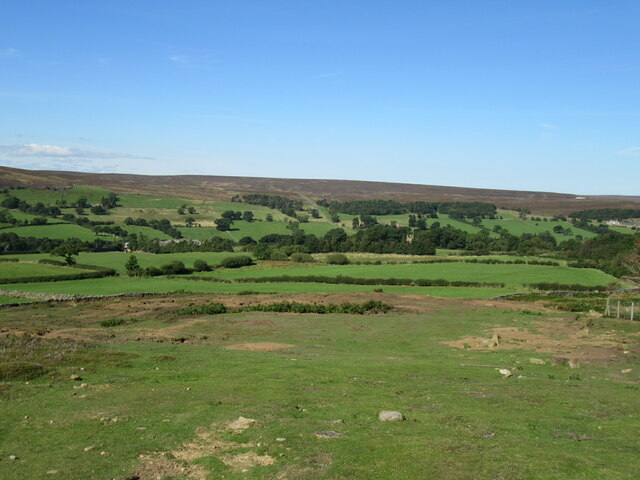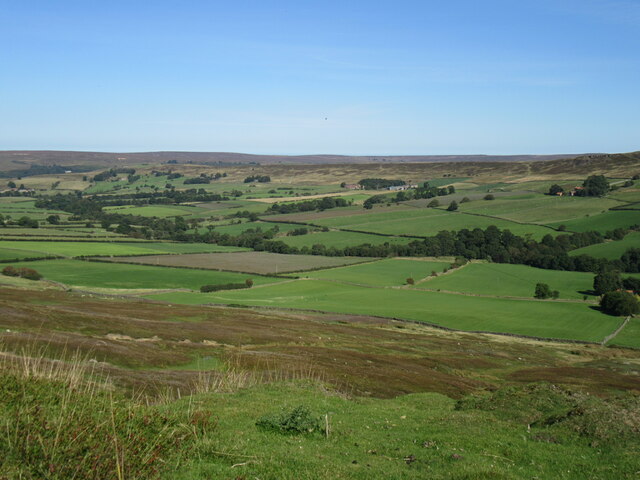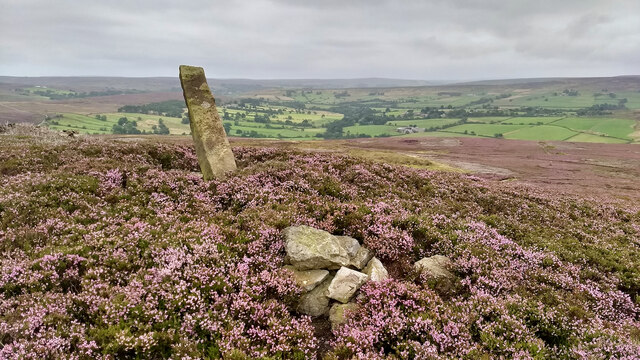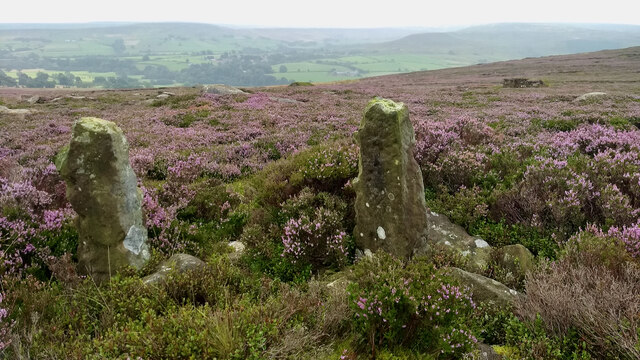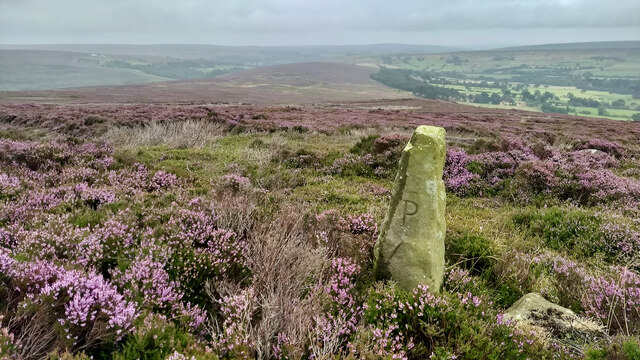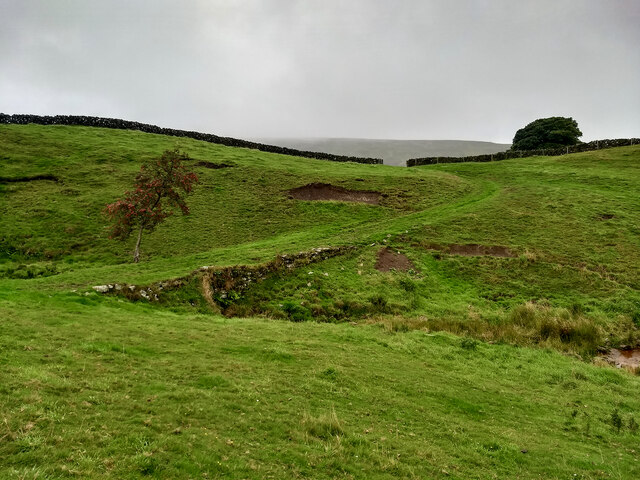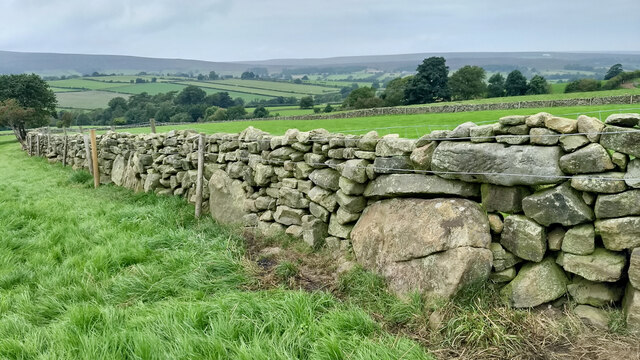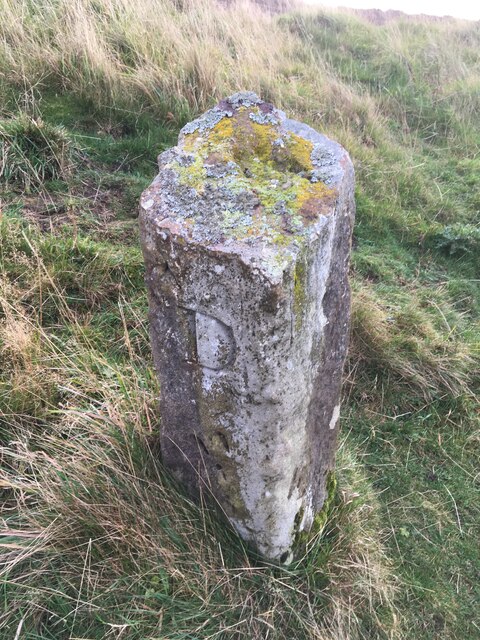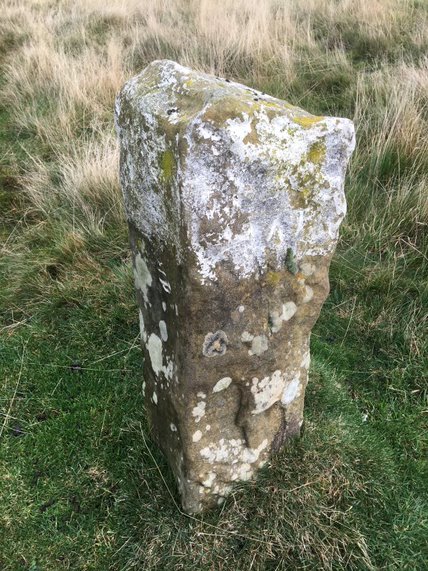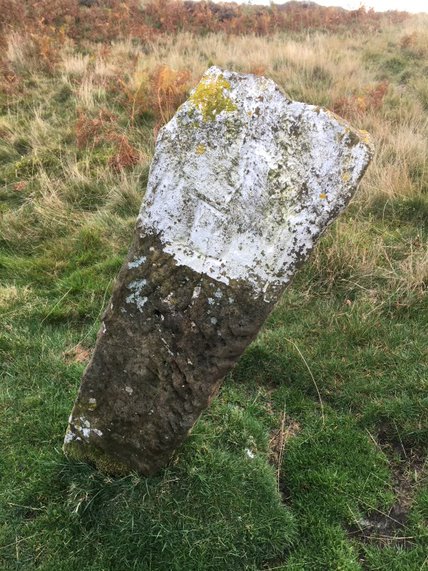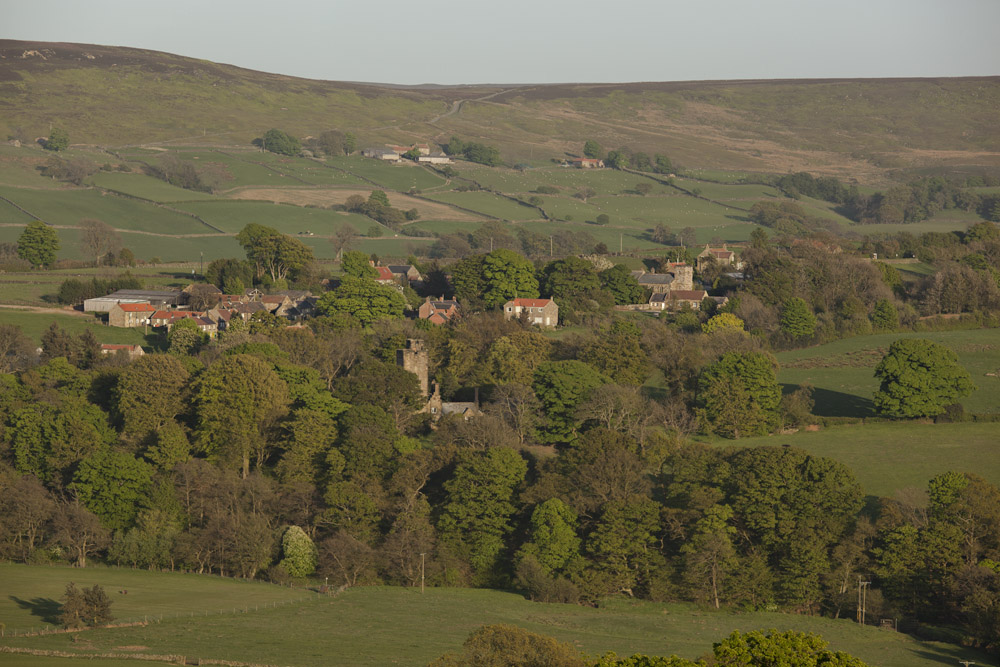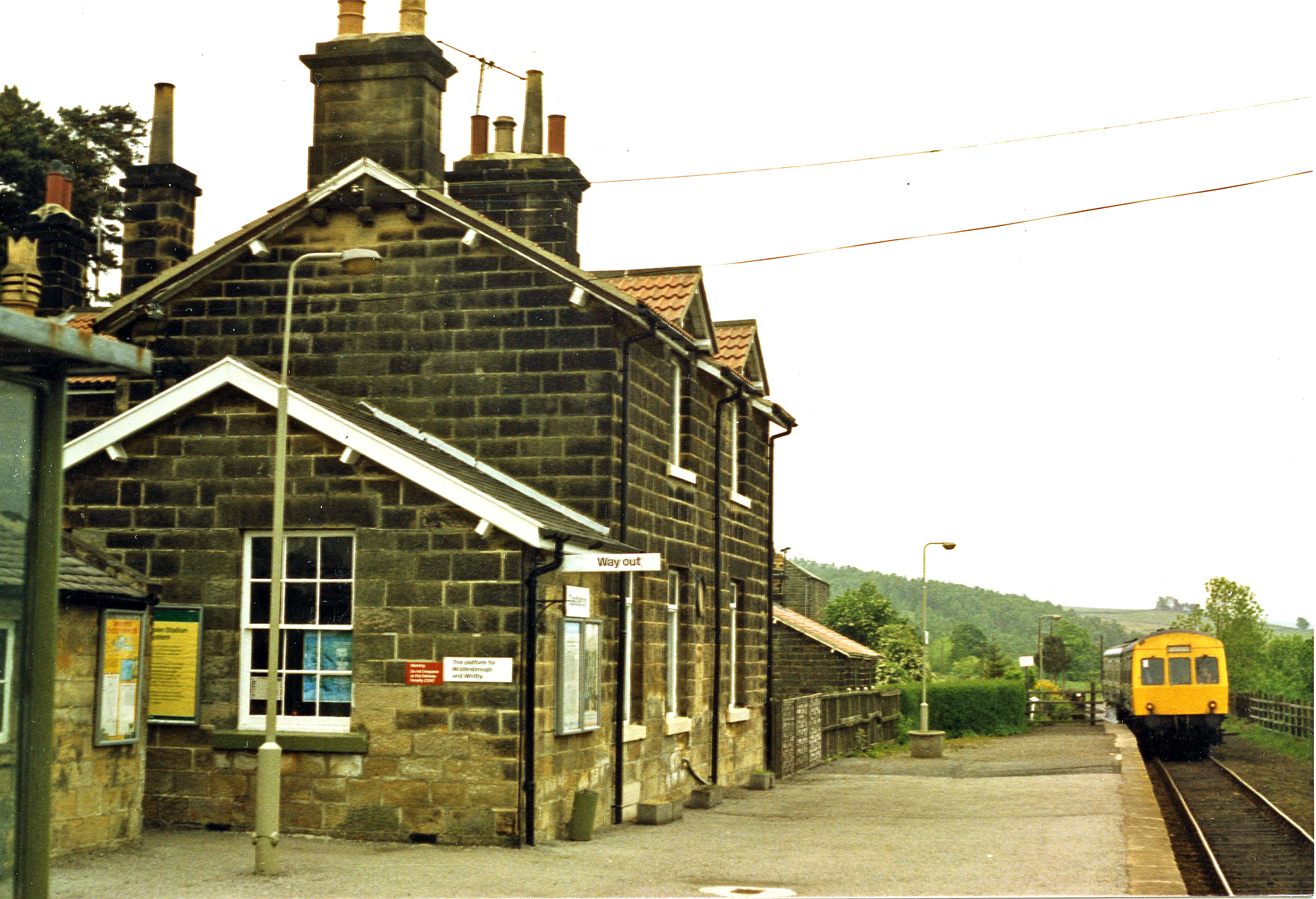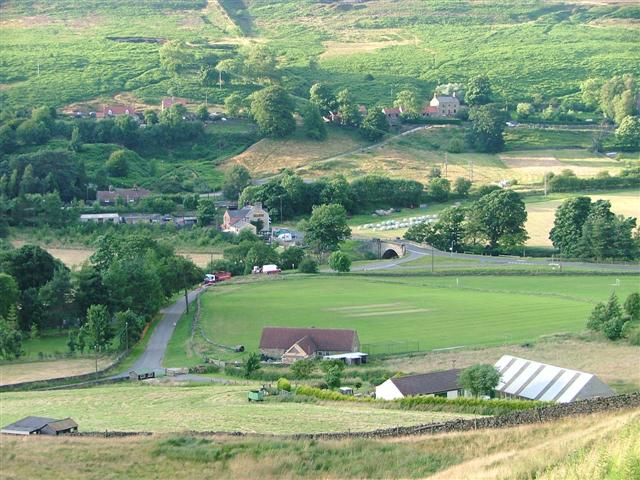Westerdale
Settlement in Yorkshire Scarborough
England
Westerdale
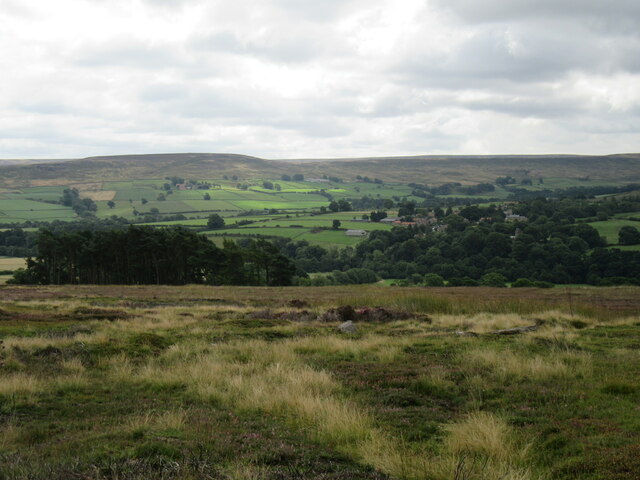
Westerdale is a picturesque village nestled in the heart of the North York Moors National Park in Yorkshire, England. Located approximately 12 miles west of the coastal town of Whitby, it is a tranquil and idyllic destination for visitors seeking a peaceful retreat.
The village is surrounded by stunning natural beauty, with rolling hills, heather-clad moors, and meandering streams. It offers an abundance of outdoor activities, making it popular among hikers, cyclists, and nature enthusiasts. The famous Lyke Wake Walk, a challenging 40-mile trail, passes through Westerdale, attracting adventurous trekkers.
Westerdale itself is a small, close-knit community, with a population of around 100 residents. It comprises traditional stone houses and cottages, adding to its timeless charm. The village is characterized by a sense of serenity and tranquility, with little traffic or noise pollution.
The village is home to a quaint church, St. Mary's, which dates back to the 12th century. It serves as a focal point for the community and holds regular services. Westerdale also has a village hall, which hosts various social events and gatherings throughout the year.
Although there are no shops or amenities within the village, the nearby town of Castleton provides basic services, including a convenience store and a few cozy pubs serving hearty meals. The closest railway station is in Danby, around 6 miles away, offering easy access to the wider region.
Overall, Westerdale offers a captivating blend of natural beauty, rural charm, and a strong sense of community, making it an enchanting destination for those seeking respite from the hustle and bustle of modern life.
If you have any feedback on the listing, please let us know in the comments section below.
Westerdale Images
Images are sourced within 2km of 54.445027/-0.97739466 or Grid Reference NZ6605. Thanks to Geograph Open Source API. All images are credited.
![Round Hill Iron Age hillfort Although a much brandied term, believe it or not there are only a handful of prehistoric fortified sites recorded within the North York Moors. All, with one exception, are ‘Promontory Forts‘, the exception being Round Hill in Westerdale.
These Promontory Forts are generally located on the Cleveland and Hambleton Hills: Eston Nab, Roulston Scar, Boltby Scar, Live Moor. They date from the Late Bronze Age to the Iron Age, at various times in the millennium before the Romans came. Their position on the cliff edges and promontories suggest there primary purpose was defensive, a place of protection for a community at night and in times of emergency.
Round Hill is technically a mutivallate hillfort, which means having two or more lines of earthwork ditches. Although it’s on a hill, it is in the upper reaches of a spur of Westerdale and is surrounded by higher moors. It resembles a little brother to the well-known Maiden Castle in Dorset, and would have been clearly visible from within the surrounding dale. A high status residence and statement of local power.
The site is entirely on private farmland so an opportunity to visit was not to be missed. Like Maiden Castle, the best photographed would be from above using a drone. Furthermore a band of trees covers most of the ditches. On the north east side these are discontinuous which can be partially explained by a staggered, more defendable, entrance.
The defences would be expected to have consisted of a series of imposing ramparts as well as the deep ditches. A palisade would have topped the ramparts. Today, there is no evidence of these ramparts on the inside of the ditches but the fortified area has been well ploughed over the millennia. This morning, a large bull and his cows and calves protected this central plateau. Within this fortified area there would likely have been dwellings, shelters for livestock and storage areas for food and weaponry. The site is located on the main ironstone seam and field walking has produced evidence of low temperature slag, a characteristic of early iron smelting.
No archaeological exploration has ever been done. A 16th-century document refers to the hill as ‘Burnt Oak Hill’. The same document also names the collection of farmsteads along the upper east side of the dale as ‘Trowsdale’. Both names have now been lost to history.
From my blog <span class="nowrap"><a title="http://www.fhithich.uk/?p=26305" rel="nofollow ugc noopener" href="http://www.fhithich.uk/?p=26305">Link</a><img style="margin-left:2px;" alt="External link" title="External link - shift click to open in new window" src="https://s1.geograph.org.uk/img/external.png" width="10" height="10"/></span>
Sources:
The official blog for the North York Moors National Park. Available at: <span class="nowrap"><a title="https://northyorkmoorsnationalpark.wordpress.com/2019/01/21/fortifying-the-landscape/" rel="nofollow ugc noopener" href="https://northyorkmoorsnationalpark.wordpress.com/2019/01/21/fortifying-the-landscape/">Link</a><img style="margin-left:2px;" alt="External link" title="External link - shift click to open in new window" src="https://s1.geograph.org.uk/img/external.png" width="10" height="10"/></span> [Accessed 26 Aug. 2021]
Wilson, Carol M. &quot;Westerdale: the origins and development of a medieval settlement&quot;. ISBN 978-0-9565779-2-4 2013](https://s3.geograph.org.uk/geophotos/06/97/52/6975227_d1034395.jpg)
![Round Hill Iron Age hillfort Although a much brandied term, believe it or not there are only a handful of prehistoric fortified sites recorded within the North York Moors. All, with one exception, are ‘Promontory Forts‘, the exception being Round Hill in Westerdale.
These Promontory Forts are generally located on the Cleveland and Hambleton Hills: Eston Nab, Roulston Scar, Boltby Scar, Live Moor. They date from the Late Bronze Age to the Iron Age, at various times in the millennium before the Romans came. Their position on the cliff edges and promontories suggest there primary purpose was defensive, a place of protection for a community at night and in times of emergency.
Round Hill is technically a mutivallate hillfort, which means having two or more lines of earthwork ditches. Although it’s on a hill, it is in the upper reaches of a spur of Westerdale and is surrounded by higher moors. It resembles a little brother to the well-known Maiden Castle in Dorset, and would have been clearly visible from within the surrounding dale. A high status residence and statement of local power.
The site is entirely on private farmland so an opportunity to visit was not to be missed. Like Maiden Castle, the best photographed would be from above using a drone. Furthermore a band of trees covers most of the ditches. On the north east side these are discontinuous which can be partially explained by a staggered, more defendable, entrance.
The defences would be expected to have consisted of a series of imposing ramparts as well as the deep ditches. A palisade would have topped the ramparts. Today, there is no evidence of these ramparts on the inside of the ditches but the fortified area has been well ploughed over the millennia. This morning, a large bull and his cows and calves protected this central plateau. Within this fortified area there would likely have been dwellings, shelters for livestock and storage areas for food and weaponry. The site is located on the main ironstone seam and field walking has produced evidence of low temperature slag, a characteristic of early iron smelting.
No archaeological exploration has ever been done. A 16th-century document refers to the hill as ‘Burnt Oak Hill’. The same document also names the collection of farmsteads along the upper east side of the dale as ‘Trowsdale’. Both names have now been lost to history.
From my blog <span class="nowrap"><a title="http://www.fhithich.uk/?p=26305" rel="nofollow ugc noopener" href="http://www.fhithich.uk/?p=26305">Link</a><img style="margin-left:2px;" alt="External link" title="External link - shift click to open in new window" src="https://s1.geograph.org.uk/img/external.png" width="10" height="10"/></span>
Sources:
The official blog for the North York Moors National Park. Available at: <span class="nowrap"><a title="https://northyorkmoorsnationalpark.wordpress.com/2019/01/21/fortifying-the-landscape/" rel="nofollow ugc noopener" href="https://northyorkmoorsnationalpark.wordpress.com/2019/01/21/fortifying-the-landscape/">Link</a><img style="margin-left:2px;" alt="External link" title="External link - shift click to open in new window" src="https://s1.geograph.org.uk/img/external.png" width="10" height="10"/></span> [Accessed 26 Aug. 2021]
Wilson, Carol M. &quot;Westerdale: the origins and development of a medieval settlement&quot;. ISBN 978-0-9565779-2-4 2013](https://s1.geograph.org.uk/geophotos/06/97/52/6975229_7985d6d0.jpg)
![Round Hill Iron Age hillfort Although a much brandied term, believe it or not there are only a handful of prehistoric fortified sites recorded within the North York Moors. All, with one exception, are ‘Promontory Forts‘, the exception being Round Hill in Westerdale.
These Promontory Forts are generally located on the Cleveland and Hambleton Hills: Eston Nab, Roulston Scar, Boltby Scar, Live Moor. They date from the Late Bronze Age to the Iron Age, at various times in the millennium before the Romans came. Their position on the cliff edges and promontories suggest there primary purpose was defensive, a place of protection for a community at night and in times of emergency.
Round Hill is technically a mutivallate hillfort, which means having two or more lines of earthwork ditches. Although it’s on a hill, it is in the upper reaches of a spur of Westerdale and is surrounded by higher moors. It resembles a little brother to the well-known Maiden Castle in Dorset, and would have been clearly visible from within the surrounding dale. A high status residence and statement of local power.
The site is entirely on private farmland so an opportunity to visit was not to be missed. Like Maiden Castle, the best photographed would be from above using a drone. Furthermore a band of trees covers most of the ditches. On the north east side these are discontinuous which can be partially explained by a staggered, more defendable, entrance.
The defences would be expected to have consisted of a series of imposing ramparts as well as the deep ditches. A palisade would have topped the ramparts. Today, there is no evidence of these ramparts on the inside of the ditches but the fortified area has been well ploughed over the millennia. This morning, a large bull and his cows and calves protected this central plateau. Within this fortified area there would likely have been dwellings, shelters for livestock and storage areas for food and weaponry. The site is located on the main ironstone seam and field walking has produced evidence of low temperature slag, a characteristic of early iron smelting.
No archaeological exploration has ever been done. A 16th-century document refers to the hill as ‘Burnt Oak Hill’. The same document also names the collection of farmsteads along the upper east side of the dale as ‘Trowsdale’. Both names have now been lost to history.
From my blog <span class="nowrap"><a title="http://www.fhithich.uk/?p=26305" rel="nofollow ugc noopener" href="http://www.fhithich.uk/?p=26305">Link</a><img style="margin-left:2px;" alt="External link" title="External link - shift click to open in new window" src="https://s1.geograph.org.uk/img/external.png" width="10" height="10"/></span>
Sources:
The official blog for the North York Moors National Park. Available at: <span class="nowrap"><a title="https://northyorkmoorsnationalpark.wordpress.com/2019/01/21/fortifying-the-landscape/" rel="nofollow ugc noopener" href="https://northyorkmoorsnationalpark.wordpress.com/2019/01/21/fortifying-the-landscape/">Link</a><img style="margin-left:2px;" alt="External link" title="External link - shift click to open in new window" src="https://s1.geograph.org.uk/img/external.png" width="10" height="10"/></span> [Accessed 26 Aug. 2021]
Wilson, Carol M. &quot;Westerdale: the origins and development of a medieval settlement&quot;. ISBN 978-0-9565779-2-4 2013](https://s0.geograph.org.uk/geophotos/06/97/52/6975232_bf826c26.jpg)
![Round Hill Iron Age hillfort Although a much brandied term, believe it or not there are only a handful of prehistoric fortified sites recorded within the North York Moors. All, with one exception, are ‘Promontory Forts‘, the exception being Round Hill in Westerdale.
These Promontory Forts are generally located on the Cleveland and Hambleton Hills: Eston Nab, Roulston Scar, Boltby Scar, Live Moor. They date from the Late Bronze Age to the Iron Age, at various times in the millennium before the Romans came. Their position on the cliff edges and promontories suggest there primary purpose was defensive, a place of protection for a community at night and in times of emergency.
Round Hill is technically a mutivallate hillfort, which means having two or more lines of earthwork ditches. Although it’s on a hill, it is in the upper reaches of a spur of Westerdale and is surrounded by higher moors. It resembles a little brother to the well-known Maiden Castle in Dorset, and would have been clearly visible from within the surrounding dale. A high status residence and statement of local power.
The site is entirely on private farmland so an opportunity to visit was not to be missed. Like Maiden Castle, the best photographed would be from above using a drone. Furthermore a band of trees covers most of the ditches. On the north east side these are discontinuous which can be partially explained by a staggered, more defendable, entrance.
The defences would be expected to have consisted of a series of imposing ramparts as well as the deep ditches. A palisade would have topped the ramparts. Today, there is no evidence of these ramparts on the inside of the ditches but the fortified area has been well ploughed over the millennia. This morning, a large bull and his cows and calves protected this central plateau. Within this fortified area there would likely have been dwellings, shelters for livestock and storage areas for food and weaponry. The site is located on the main ironstone seam and field walking has produced evidence of low temperature slag, a characteristic of early iron smelting.
No archaeological exploration has ever been done. A 16th-century document refers to the hill as ‘Burnt Oak Hill’. The same document also names the collection of farmsteads along the upper east side of the dale as ‘Trowsdale’. Both names have now been lost to history.
From my blog <span class="nowrap"><a title="http://www.fhithich.uk/?p=26305" rel="nofollow ugc noopener" href="http://www.fhithich.uk/?p=26305">Link</a><img style="margin-left:2px;" alt="External link" title="External link - shift click to open in new window" src="https://s1.geograph.org.uk/img/external.png" width="10" height="10"/></span>
Sources:
The official blog for the North York Moors National Park. Available at: <span class="nowrap"><a title="https://northyorkmoorsnationalpark.wordpress.com/2019/01/21/fortifying-the-landscape/" rel="nofollow ugc noopener" href="https://northyorkmoorsnationalpark.wordpress.com/2019/01/21/fortifying-the-landscape/">Link</a><img style="margin-left:2px;" alt="External link" title="External link - shift click to open in new window" src="https://s1.geograph.org.uk/img/external.png" width="10" height="10"/></span> [Accessed 26 Aug. 2021]
Wilson, Carol M. &quot;Westerdale: the origins and development of a medieval settlement&quot;. ISBN 978-0-9565779-2-4 2013](https://s1.geograph.org.uk/geophotos/06/97/52/6975233_2bd45db8.jpg)
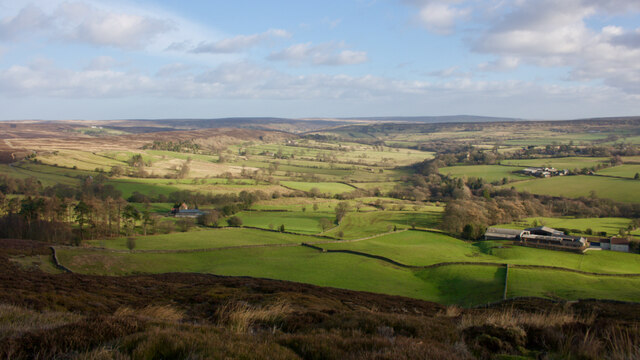
Westerdale is located at Grid Ref: NZ6605 (Lat: 54.445027, Lng: -0.97739466)
Division: North Riding
Administrative County: North Yorkshire
District: Scarborough
Police Authority: North Yorkshire
What 3 Words
///share.rationing.shocking. Near Danby, North Yorkshire
Nearby Locations
Related Wikis
Westerdale Preceptory
Westerdale Preceptory was a priory in Westerdale, North Yorkshire, England. The land was donated to the Knights Templar by Guido de Bovingcourt in 1203...
Westerdale
Westerdale is a village, civil parish and dale within the Scarborough district of North Yorkshire, England. The Esk Valley Walk runs through part of the...
Castleton Moor railway station
Castleton Moor is a railway station on the Esk Valley Line, which runs between Middlesbrough and Whitby via Nunthorpe. The station, situated 16 miles 45...
Castleton, North Yorkshire
Castleton is a village on the River Esk, part of the civil parish of Danby in the county of North Yorkshire in England. It can be found 7.1 miles (11.5...
Related Videos
Our Stay at Millinder House - The Carthouse | The North York Moors | Miss18Dapper | January 2022
Our stay at Millinder House - The Carthouse. Situated in the North York Moors National Park. Is a beautiful, peaceful place for a ...
New Year's Eve Walk (Esk Valley Walk) | The North York Moors | Miss18Dapper | January 2022
Our stay at Millinder House - The Carthouse. Situated in the North York Moors National Park. Is a beautiful, peaceful place for a ...
Esklet's Crags & Westerdale Crags, North York Moors - 9 April 2023
A 6 mile walk from the parking area at the junction of Blakey Lane and Knott Road. The route heads west towards Esklet's Crags ...
View from Westerdale Moor part 1
Easby Moor, right in the way, blocking the view of Roseberry Topping. Oops. Batteries ran flat. Part 2 follows!
Nearby Amenities
Located within 500m of 54.445027,-0.97739466Have you been to Westerdale?
Leave your review of Westerdale below (or comments, questions and feedback).
